How many management or planning tools would you say you’ve tried? Do you remember why you switched from one to the other? For me, the answer is “I don’t know”. To both questions. Over and over again…
It could have been a recommendation from a colleague, a fancy new feature you spotted, or the tool that your new company has always used. If you were to ask “why this one?”, the answer would usually be (if it’s not “I don’t know”) about feature(s). It could be an integration that you feel is essential, or the shortcuts that you know and love, or even its good apps if you never want to escape work notifications. However, these answers all have one thing in common - they’re not about the work that goes into them. That almost feels secondary.
The latest tool I’ve been using is Asana. What I’ve found after using it for a few months now is that the focus is less about features. Instead, it feels as though it has been designed to actually alter and improve how you manage work. It’s not just a slick design on top of everything you’ve seen and used before in other tools, it’s a chance to take a step back and evaluate your process - for your work, your teams work, and how you review and share that work. An important differentiation I’ve read between popular tools like Trello and Asana is that they are work management tools, and Asana is a team management tool. I know that sounds pretty vague, but it’s the main reason I love it. After getting comfortable using Asana, I’m now happy to write about why this approach makes such a clear difference over other popular work management tools.
This is not a full comparison of the pros and cons of both of these tools - there are already more than enough of those! If you are interested, check out this very thorough comparison by Cloudwards. This is just one humble managers opinion of transitioning from Trello, that I’ve used for years, to Asana, which I’ve now used for months, and why I’m not going back to the former any time soon.
I’ve split this into three piles:
- 😎 Cool features
- 🤯 Absolute game-changing features
- 😔 Things I still miss from Trello
Note: This is all written from the perspective of someone working on Asana’s free plan, however I’ve had a chance to play with a couple of the business tier features that I think could make a big difference to how you manage work and the work of others. All of the features I truly love are in the free plan (as I’ve worked with them for a while now), so in my opinion your ability to effectively use Asana isn’t stuck behind a pay wall.
Let’s get into it!
Cool features
A range of work views
The first and most obvious difference I spotted when I first used Asana was the range of ways that you could view work depending on how you wanted to approach it and what made sense at the time, all using the same data.
There’s a Kanban style (you’d be used to in Trello) which is comfortably like all the others:
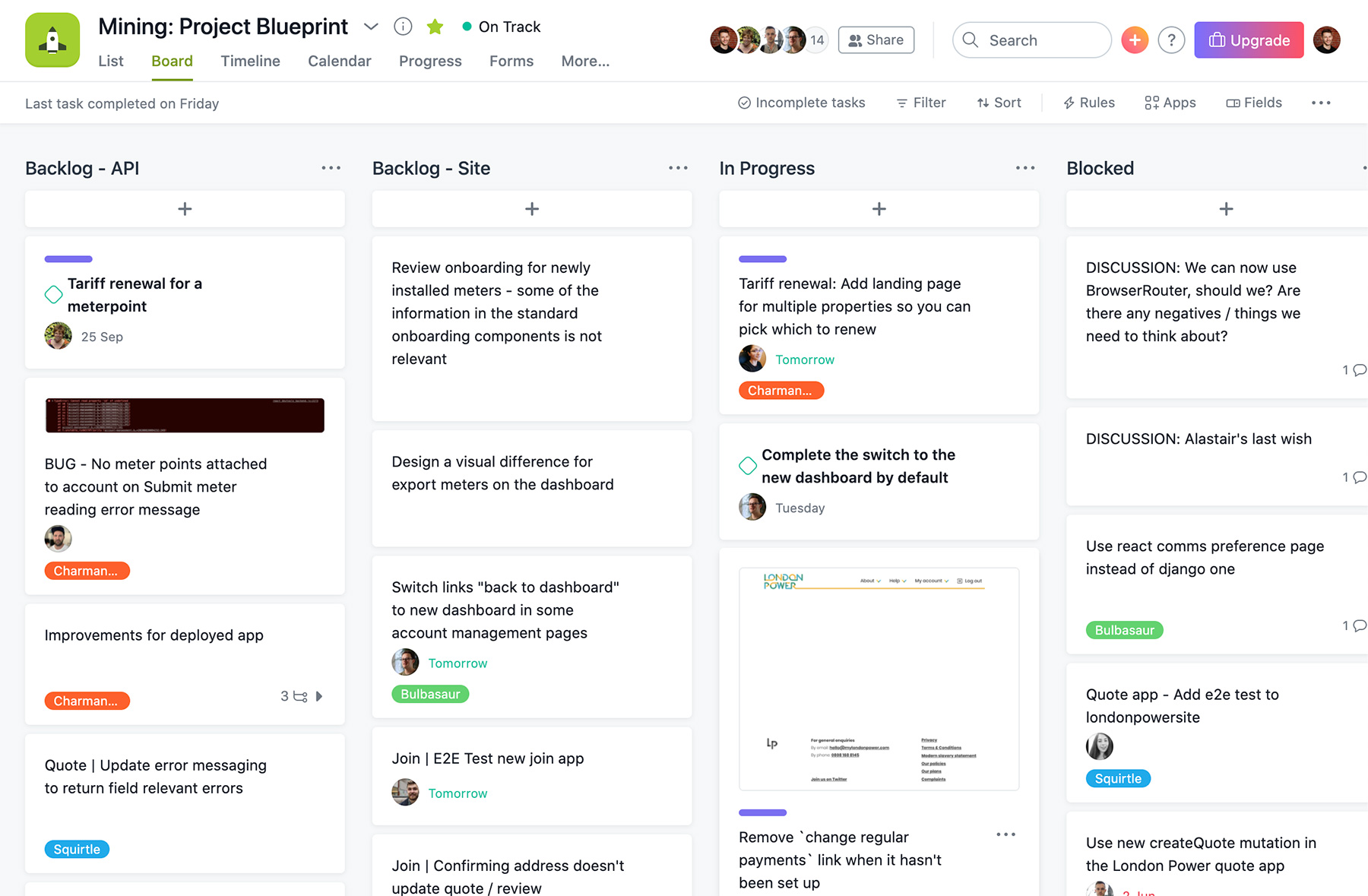
There’s also the Timeline view, which is basically a Gantt layout:

Then there’s a standard list view which is handy for quick card sorting and group actions, and finally the Calendar view… to be honest I haven’t really found use for this one, especially with there being a few people in my team.
Milestones and dependant cards
Good start, but we need more. Now all of your work is in service of certain goals - checkpoints along the way on a board that will likely never be finished. Some of it may be directly related to other parts (“I can only do A once I’ve accomplished B”), or it may be completely standalone. Either way, it should be represented in some way. You could create a board for each smaller piece of work, but that feels excessive. Asana has a better way though. How about milestones in a board?
Milestones are distinguished by this icon:
![]()
They appear in all Asana views, so you can differentiate them from regular cards, and see when you’re making tangible progress towards your goals.
Milestones are, by definition though, larger goals, and a lot contributes to getting there - things that have to be done first in order to achieve what you’ve set out to do. Luckily, this can also be visualised using “dependant” cards.
Because of this, you can make any card or milestone dependant on any number of cards before it can be unblocked or accomplished. This way it’s clear what’s left to be done to reach that milestone, or even to just unlock the next piece of work. It also helps everyone working towards that milestone remain aware of the value of what they’re doing.
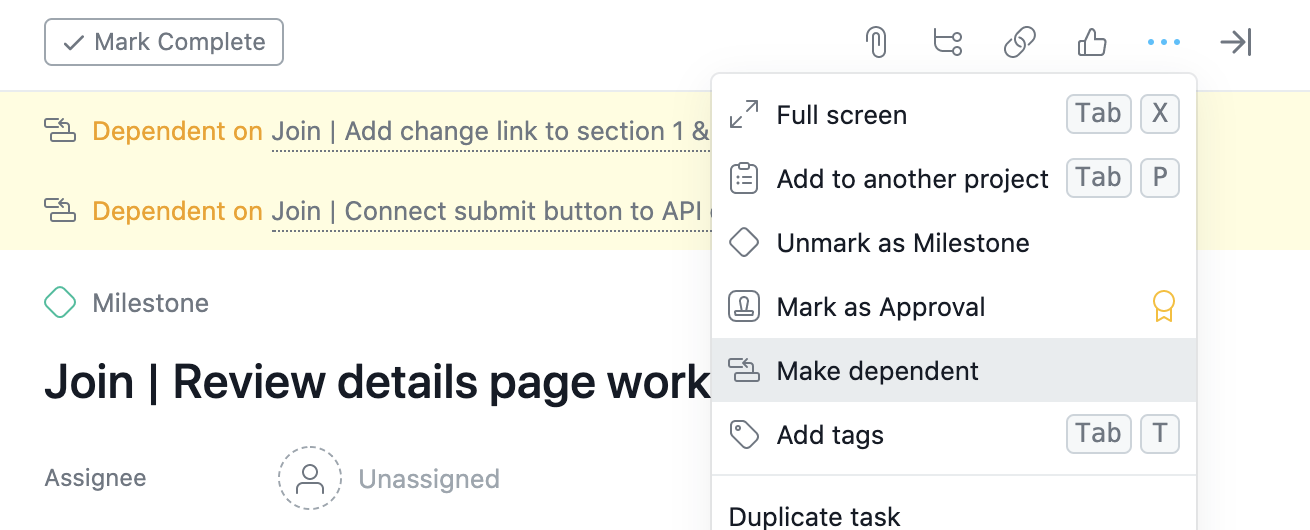
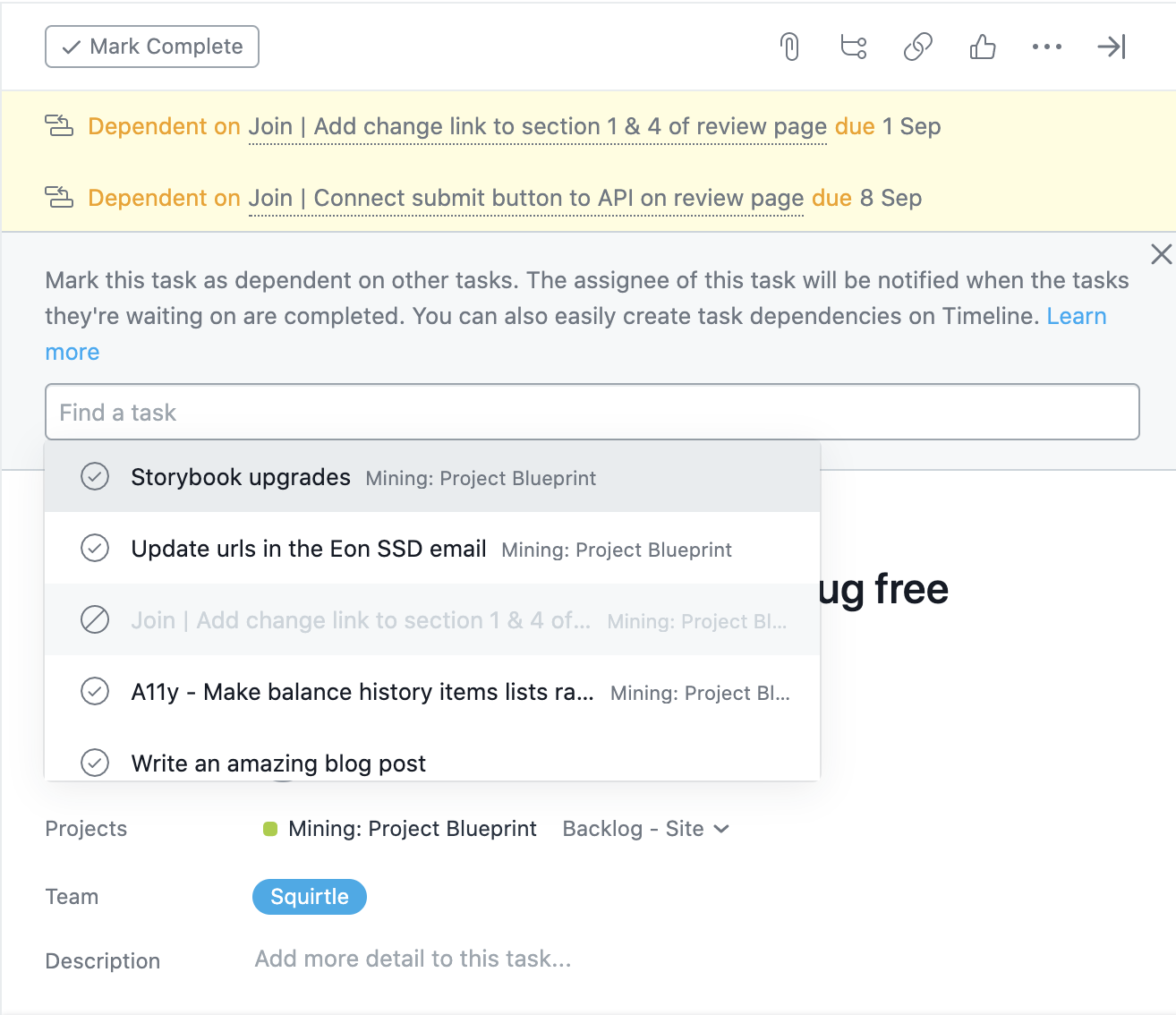
Once this is done, a card that has any dependants will be displayed at the top:
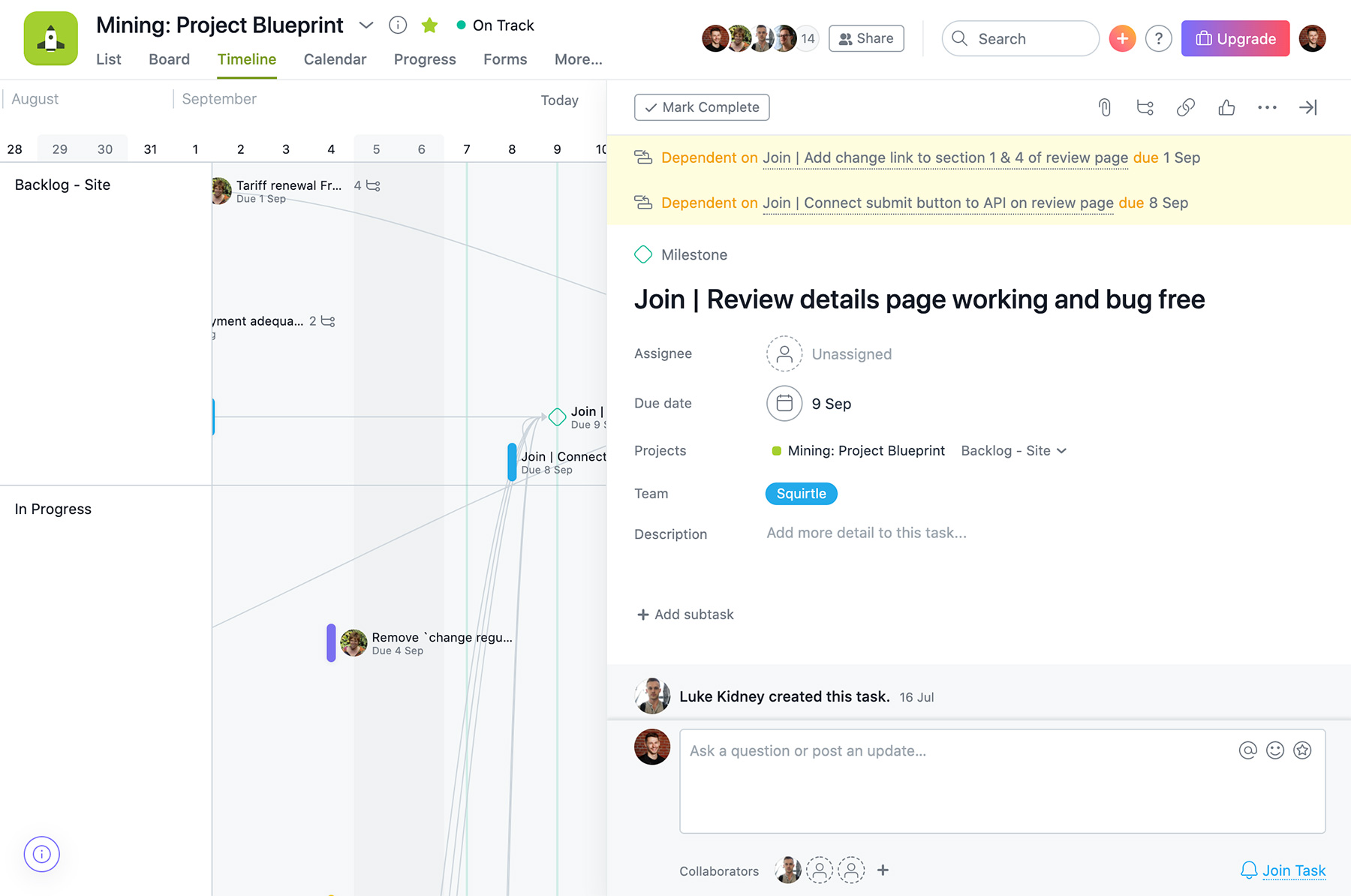
So the relationship is always clear.
When milestones and dependant cards are used together, the result is a clear visual, particularly in the timeline view, of what you’re aiming towards, and what will need to be done in order to get there:
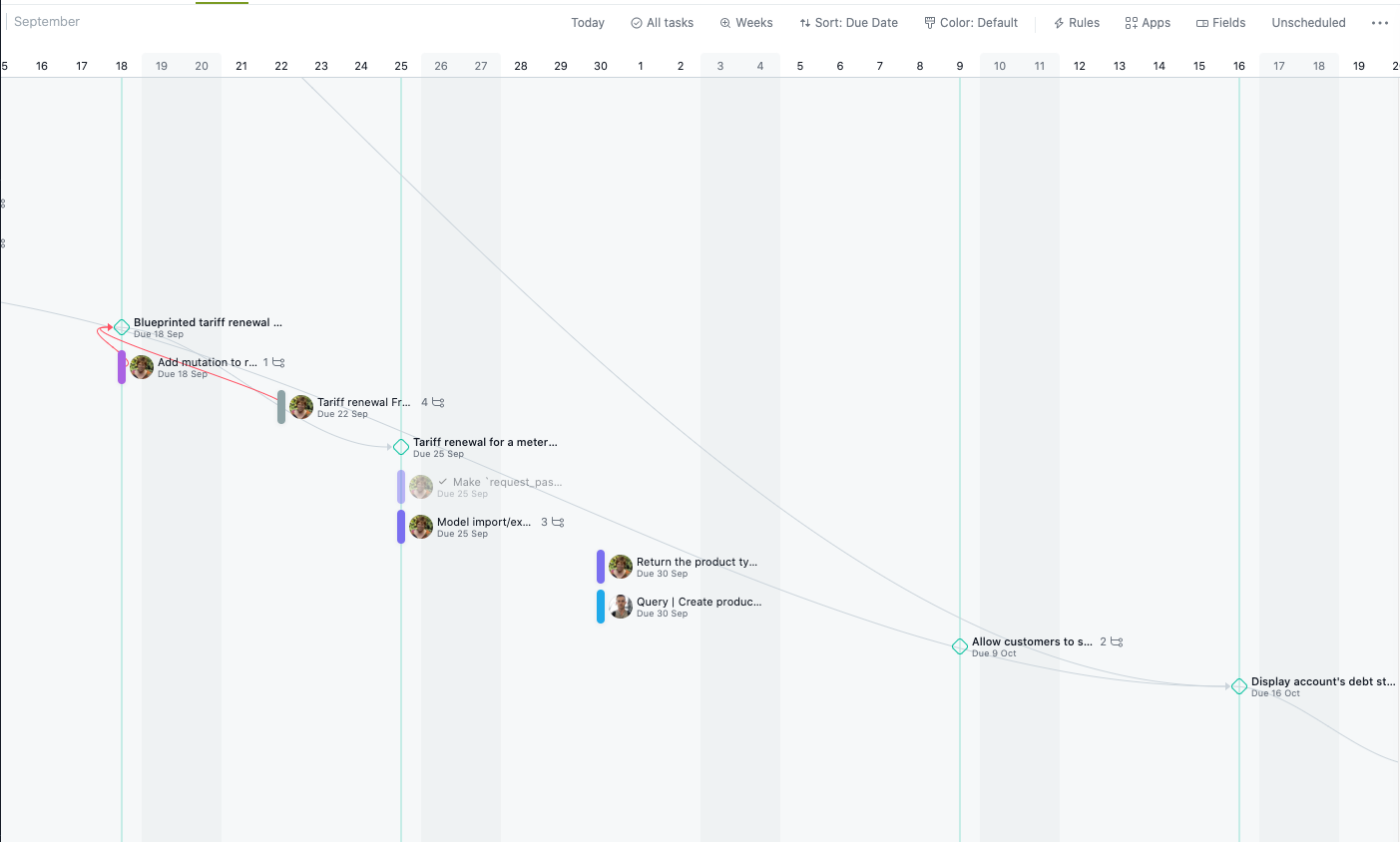
It’s clear that a lot of thought has gone into the function of a card rather than “every card is the same”. For the same reason, you can add cards to multiple boards, so you get the benefit of compartmentalising your work, but without the usual duplication of cards you might have to suffer as a result in other tools.
Can you honestly say that your current tool gives you this power?
Custom fields
Let’s keep going! In Asana you can create as many custom fields as you like and, every time you do, they get added to a central library so that they can be used across every board consistently. This becomes especially useful when you start creating individual boards for projects or teams, and want to filter or categorise cards in the same way - the result is real consistency regardless of how you separate your work.
As an example, here is the layout for a custom “Team” field that we use across the front-end development boards:
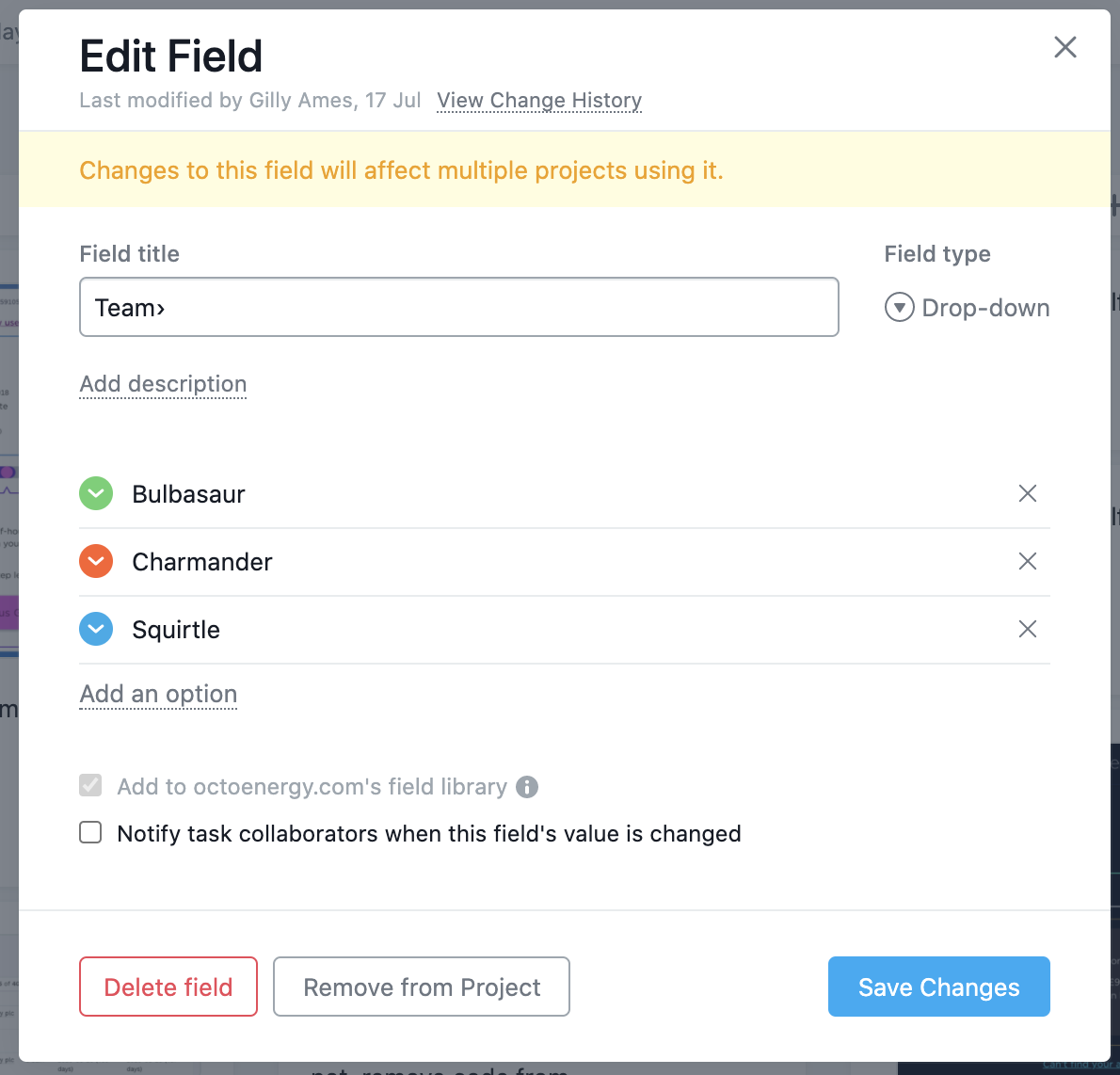
The field above has a checkbox ticked to add it to our organisation’s shared library. It can then be added as a field to any card on any board.
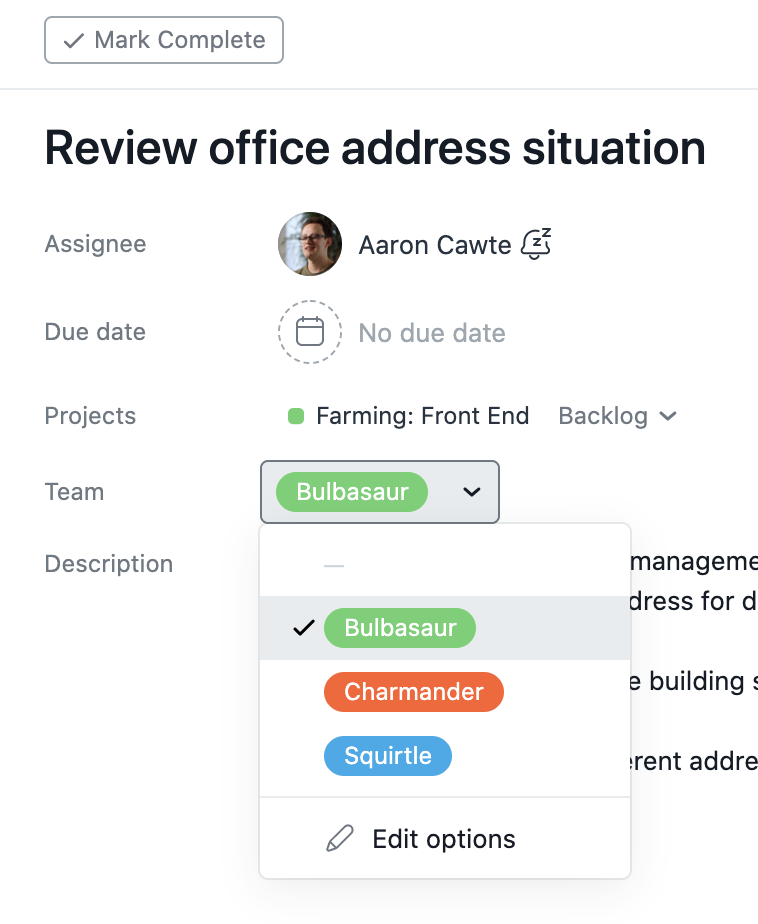
To be fair custom fields are possible in a few other tools, but they usually don’t persist across boards in the same way that they do in Asana.
Custom reports to quickly check on people, teams, projects etc. in one click
Let’s talk a little bit about the data that comes out of work. Whether you’re tracking metrics such as completed and overdue tasks as part of an agile workflow, or just keeping an eye on a particular team or developers progress, it’s handy to be able to see the “whats” and “whens” of cards once they’ve left the board you’re using.
Asana has a Reports section where you can set up as many pre-defined reports as you’d like, and they’ll all return up to date info whenever you re-open them. Here are a few examples or reports I have.
• Tasks I’ve assigned to others, so that I can see their progress
• Completed work split by team
• Work that is scheduled to be done in the next two weeks (again, by team)
• Recently completed tasks
• My completed and upcoming work so I can map my own progress
They sit in a handy sidebar so you have easy access to them, along with boards marked as your favourites. You’d be surprised how often you click on them.
Personal to-do’s
This was actually a really big one for me. I’ve been forever searching for the best way to handle to-do’s of my own without polluting a group board. I’ve hopped from a physical pen and pad, to a new app that had caught my eye, to having it in my Bear app alongside my other notes. None of these options really worked for me because, at one point or another, duplication with a work tool was inevitable. What Asana allows you to do instead is keep a list of your own personal cards under “my tasks”.
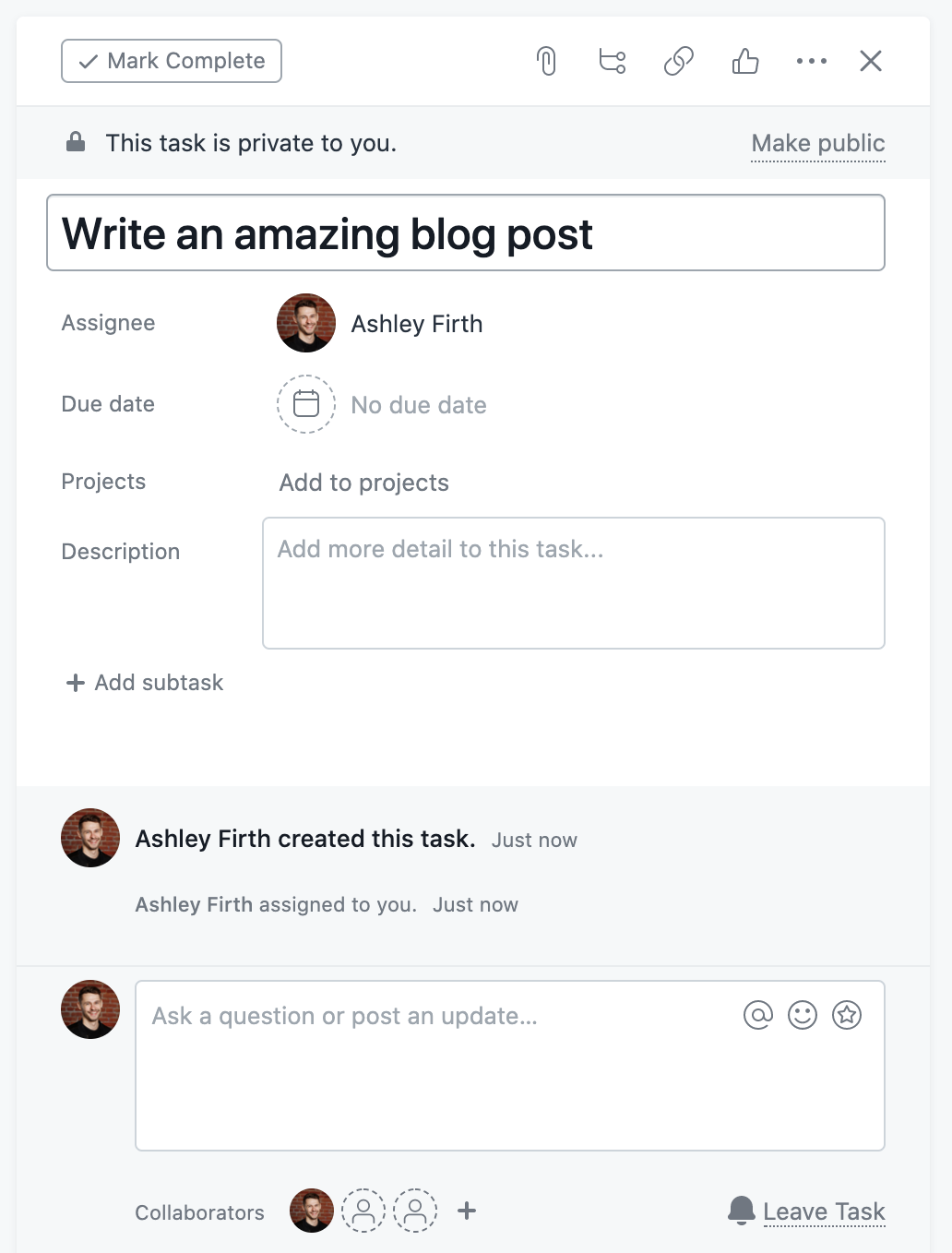
When these are first made they’re completely private, but at their core they’re still cards. This means that cards can remain hidden from everyone else but in the same format as any other work card and then, when it makes sense, can simply be added to any board at any time in a matter of seconds.
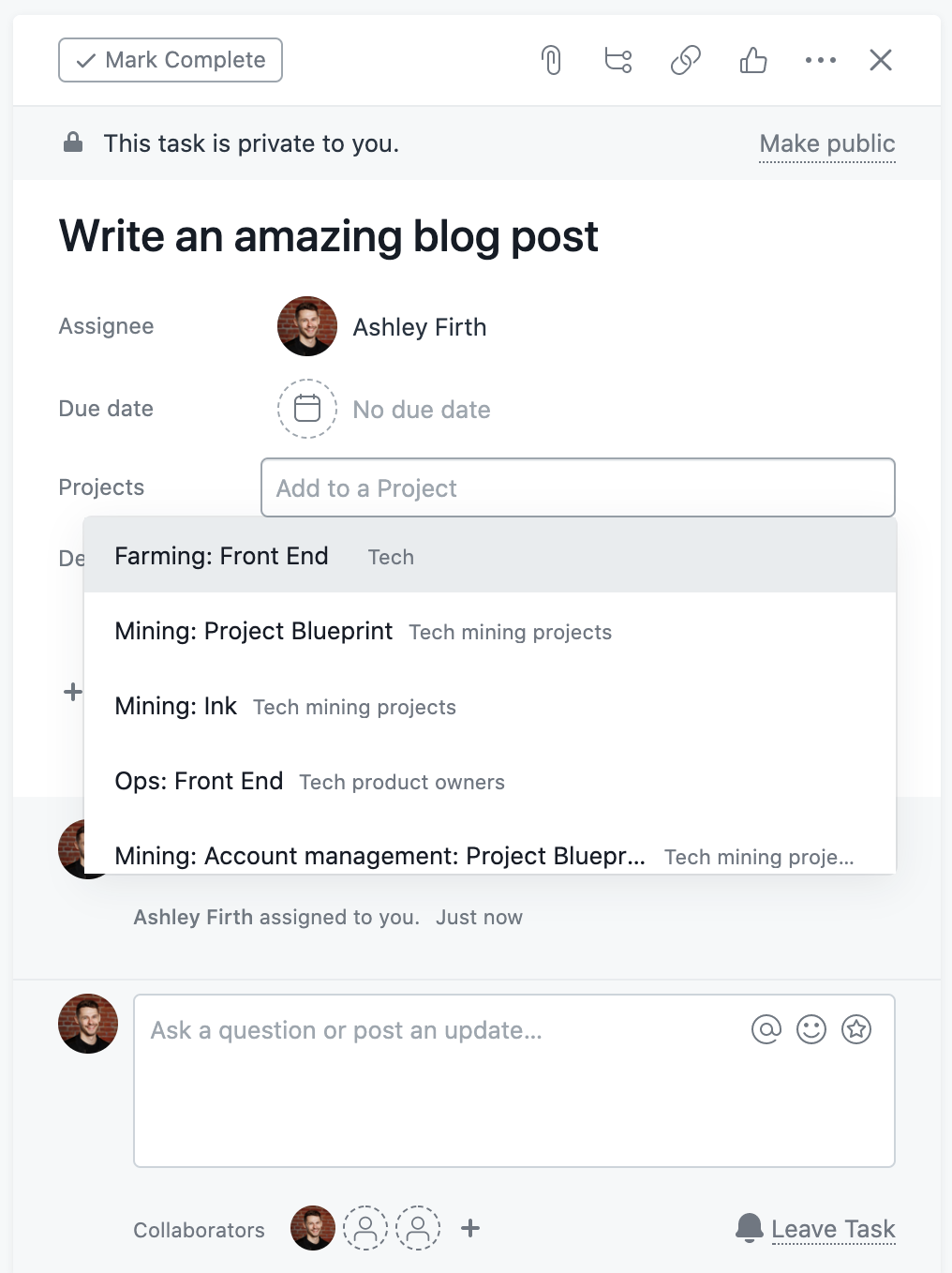
Insane amounts of keyboard shortcuts
If you know me, or have seen my previous post on mastering shortcuts, you’ll know that this is a big one for me. There’s a shortcut for just about anything in Asana, and you can find the full cheat sheet here.
One single owner of a card

Everyone else is a collaborator.
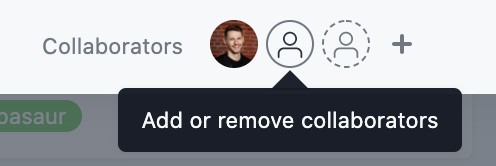
Again this is a fundamental re-think of how work and teams are managed. It creates a sense of ownership for every card, but doesn’t remove the need that often arises for others to be involved.
Absolutely game-changing features
Progress feature in Asana
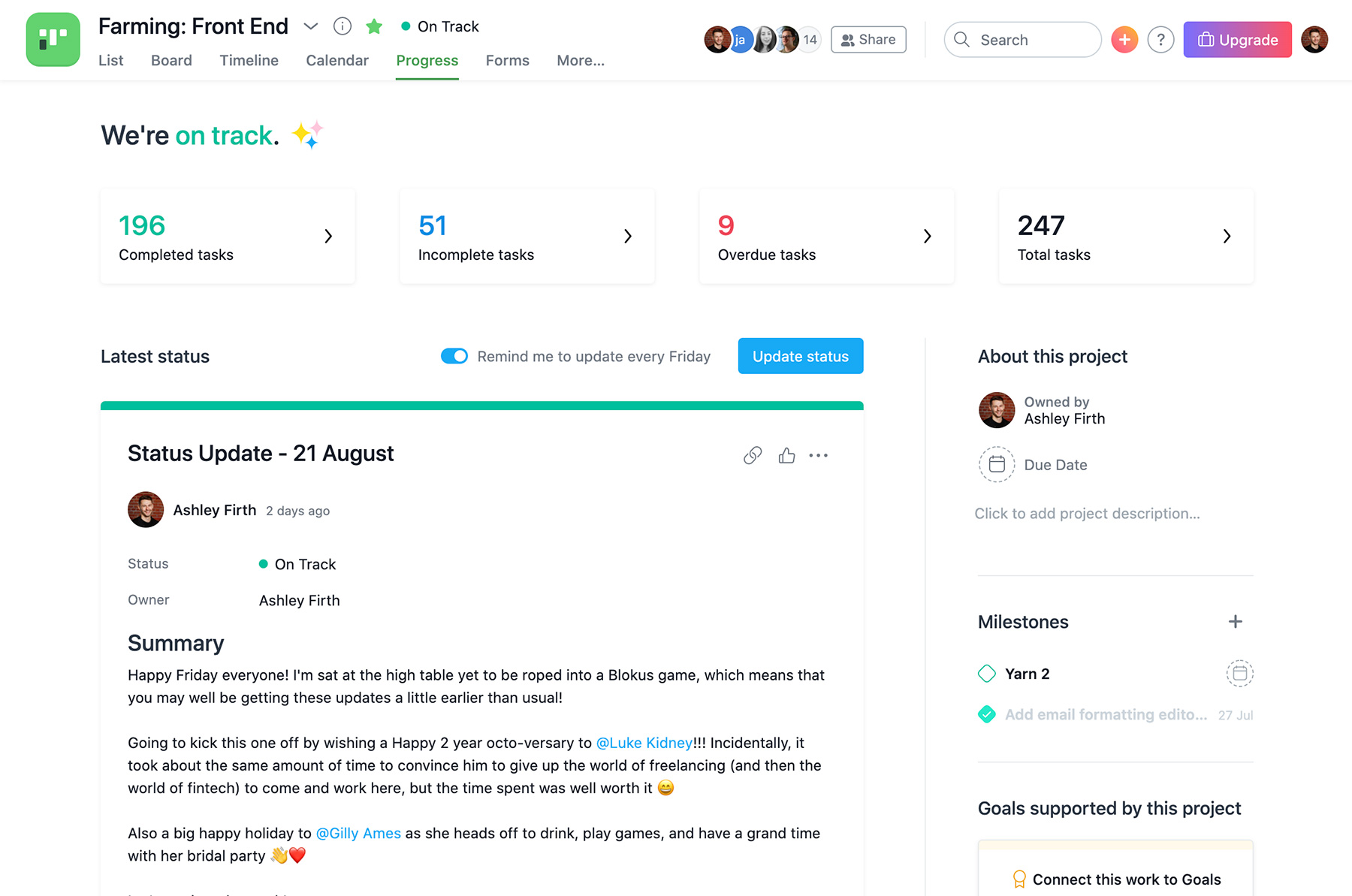
Time for some absolute game-changers, and this is probably my favourite. In Asana, you have the ability to compile status updates about the progress of your boards, showing completed and blocked work, progress tracked over time, and be read by anyone with access to the board.
A big thing I’ve been using it for is as an end-of-week round-up that you can share with others. When you’re writing it you can drag in some dynamic panels into the report that return cards matching those criteria each time you write an undated. This takes advantage of pre-selected date ranges and card statuses (completed in the last week, due to be completed in the next two weeks etc.). Then as you’re typing up overviews of what’s been done and how the week has been, if any card’s status’ update to match that rule, it’ll slot right in (once you’ve published it though it’s set in stone).
Each dynamic panel shows a dozen or so items, but you can click “add more” if there are more cards that match the rule that aren’t currently being shown.
Note: One thing that would be amazing here is the ability to pull in a specific card so it can be discussed by itself. Small, but would be handy. It’s a new feature, so maybe it’ll appear in the future.
I’ve been writing these weekly progress updates for a couple of months now, and the feedback has been excellent. People in my team have expressed how great this is to read at the end of the week - as a way of seeing what other people have managed to accomplish, to see themselves recognised for what they’ve achieved, and a bit of humour thrown in there too. I don’t just add the dynamic cards and leave it at that though: here is the layout of a typical end-of-week Front-end report:
- ✍️ A short summary of the week and any small housekeeping items
- ⭐️ Highlights / things you might have missed (everyones favourite part. I pull in links to things that happened across the week in slack, along with big news pieces, announcements around the company, and talks that were given, by us or others, with recordings so those that were absent can watch them back)
- ✅ What’s been completed (this includes a dynamic card, provided by Asana, showing cards completed in the last 7 days)
- 🔎 What’s upcoming (A top-level view of cards due in the same day - not as powerful as looking at them on a timeline, but useful all the same)
- ❌ What’s blocked. A chance for me to ensure that everyone is keeping their cards up to date (they may have forgotten to update the due date and/or description), but also a chance for me to help unblock something if somebody is waiting on a review or advice from someone I can contact.
- 🔥 Outages. A list (hopefully a short one) of outages that the Front-end team have caused this week, what had happened, a report to the full outage if it was a big one, and how long it lasted.
This isn’t just good for people in my team though - stakeholders in features, and the senior management team at Octopus, now benefit from access to this report every week. Between this regular overview (that it more comprehensive than any chat I could have with someone), along with access to the board and the various milestones we’re aiming for, means that I very rarely get “where is this feature at?” and “how long until this might be done?” questions these days.
The last point is really important, because it started a sort of self-fulfilling prophecy too. The more that Asana has the answer to people’s questions, the more likely they are to use Asana, and add their own work in there, which means it becomes an even stronger source of truth for all of our work. I definitely receive less ad-hoc requests through Slack or WhatsApp than I used to, which is always a benefit.
One thing to note is that this feature, much like a few of the above, relies on due dates (you can’t see what’s upcoming without there being a date on the card for when it’s due). I’ve actually found this to be more productive than hindering though. What it does is causes team members to be more conscious of estimating time. They learn from over and under estimating work (usually, it’s them trying to accomplish too much in a week - far from the worst problem to have).
At Octopus Energy, we don’t operate using the Agile “sprint” mentality. Instead, we are more interested in ensuring that we’re focusing on what’s truly important to the business at any one time. As a result, if someone isn’t going to make a deadline that they’ve set themselves, I tell them that it’s entirely fine to change the due date on the card, but to pop a comment on there to explain why it wasn’t possible to do it by this date. That way the board acts as not only a source of truth of what we’re working on, but what has been interfering with other work. If we find that a few cards have “didn’t make this due date, was quickly pulled onto a project by the CTO”, then there’s a conversation to be had…
Each board has a form that allows you to standardise how work comes into the board
If you’ve ever received a brief for work in one of these formats:
- 📒 A post-it note
- 😓 A one line message via slack
- 🎨 A doodle on a piece of piece
- 💬 A “could you just do this quickly?” chat
Then boy do I have the feature for you. For every board in Asana, you can create a custom form for people outside of your team to submit work to that board.
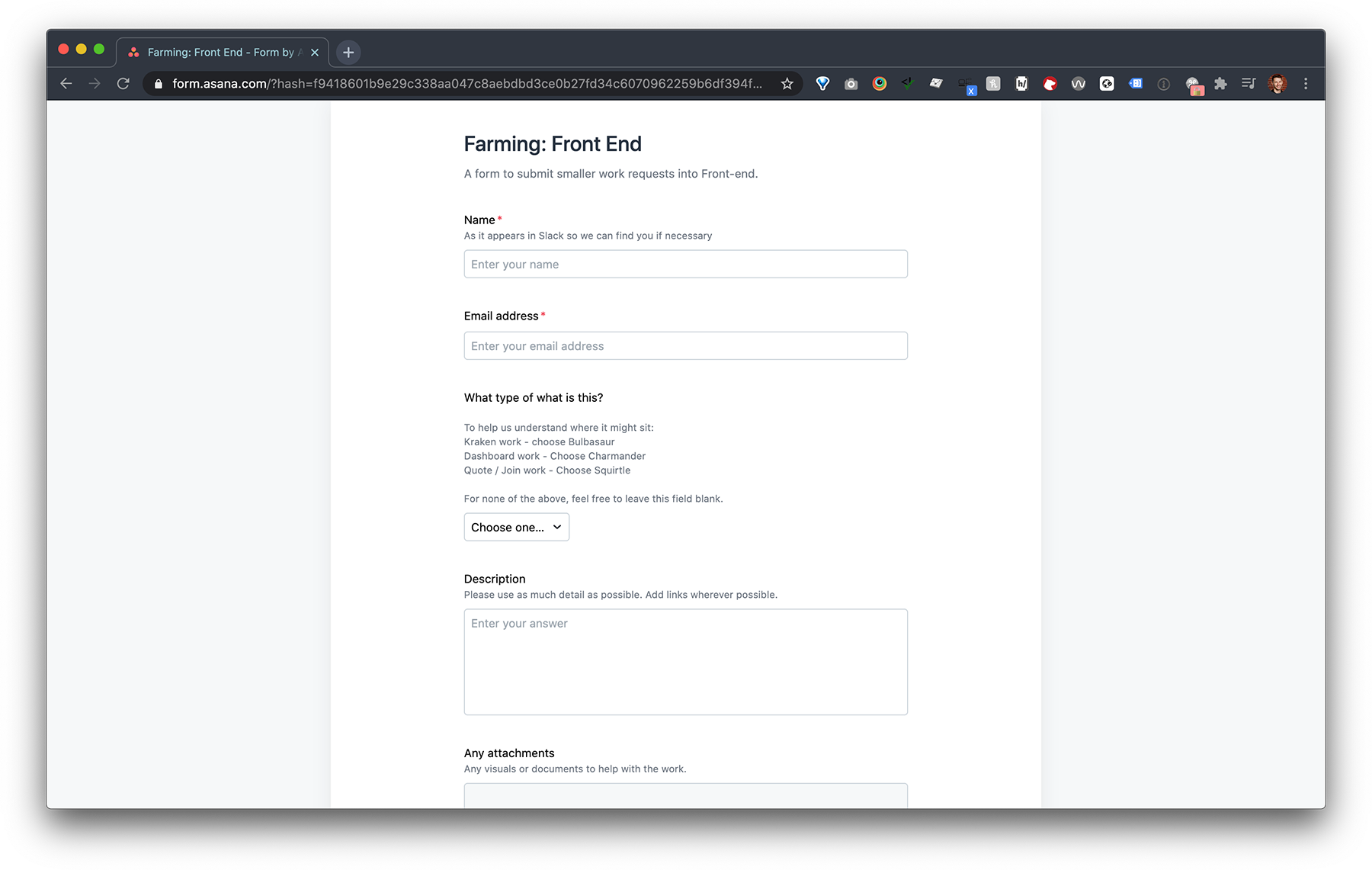
Now if you typically receive a less-than-perfect brief you just need to send them the link, have them fill it in, and you start receiving work in a standardised way, regardless of who it’s come from. It’s quite smart out of the box too - you can:
- 🗓 Set a date field and have that act as the cards due date
- ↪️ Have answers in certain fields affect the cards (in our forms, you select what type of work you’re after and, depending on the selection, it will tag the card with the appropriate team that should look at it)
- 🗣 Set a field to act as the card’s title
Note: in the business tier of Asana you can take this one step further, by automating certain actions depending on the contents of what has been submitted through the form (Is the due date for this work tomorrow? Pop it in the emergency triage column and ping Ashley…so he can work out why we’ve only heard about this now). By no means essential (particularly for smaller teams), but a neat way to scale an action once the number of requests grows.
Gone are the days of incredibly un-detailed cards that require an hour of background research and waiting for the person who submitted the card to respond.
Workload feature
I want to start by saying that this is a premium feature, and that I’ve not used this one for that long. However, the practical possibilities for this warrant it a place in the “game-changing features” section, and further re-enforces the idea that Asana truly is a team management tool and not just a work management one.
The workload feature provides you with a complete picture of everyone’s capacity within your team at a glance, and easily drill into tasks for additional detail. Asana describe it as “promoting balance and not burnout or boredom” which is a pretty neat marketing line I won’t lie. I should use that.
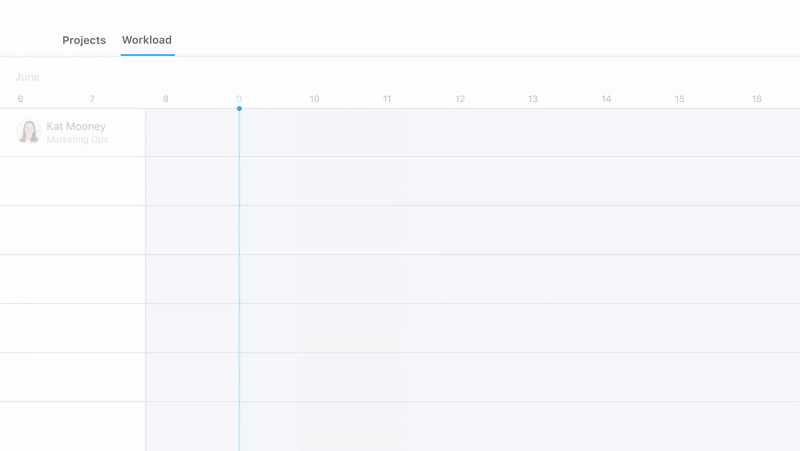
You assign a value to tasks, like hours or points, so you can estimate the effort they require and see who has too much or not enough work.
This is actually the only downside to the feature (albeit inevitable) - it requires that you assign each card an “effort” rating. You initially decide what a maximum effort level for a developer in a typical working week is (as an example, let’s say it’s 10). Once you’ve done that, you rate each task using that number as a guide, making sure that the combined effort of tasks given to a developer in a week doesn’t exceed that number.
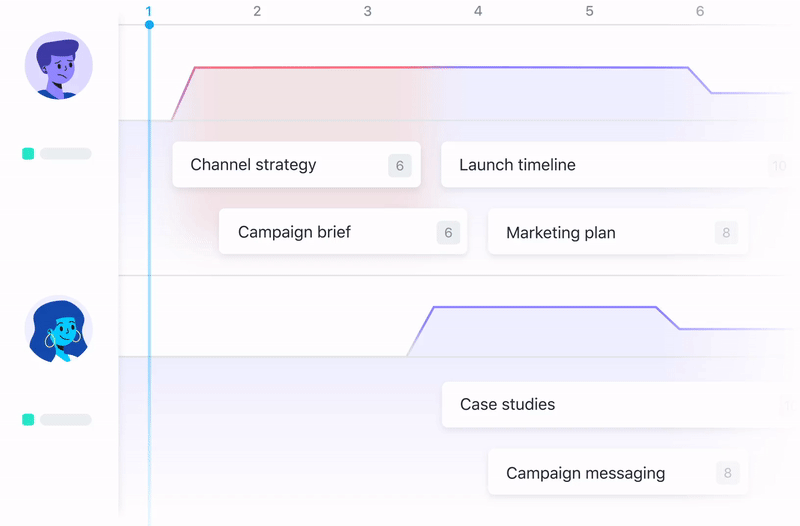
Once you’ve done that, Asana works out how heavy the workload is of that person given the time they have to complete the work, and anything else they may have on their plate at the time. The result is that you can quickly see if anyone looks a little overworked in the weeks to come and, just as importantly who might have the capacity to take something off their hands to balance things out.
Once you’ve found the right person, you can literally drag and drop work from the overworked persons stream into someone else’s to reassign and reschedule it. Asana will then re-evaluate based on this and update the graphs.
For me this is insanely powerful. People in your team are no longer snowed under because you’ve accidentally over-assigned work to them and they hadn’t mentioned anything (why would they? They would assume that you’d thought about what they had on before deciding to give it to them - that’s your job after all…😅). It also provides a visual representation to the idea that all work isn’t created equal. All work is represented in the same way, but a copy change and a complete refactor present two very different challenges in terms of effort level, and it’s great to now see that so clearly visualised.
Things I still miss from Trello
Github integration
In Trello, there is a GitHub “power up” that can connect a Trello card to a pull request - generating links on both pieces of content to the other. As the manager of a development team, this is by far my most missed feature. Having spoken to a lovely guy by the name of Bobby at Asana, I’ve been promised this is on the roadmap for new features. This is probably just the result of Asana being a tool for all types of teams, and I imagine someone somewhere is moaning just as loudly about it not having an integration for Jira or some other tool. Is its absence annoying? Yes, but it’s not a deal-breaker as far as I’m concerned.
Markdown Support
I’ve seen this request posted on Asana’s forum a number of times, so I wouldn’t be surprised if we saw this in the near future as well. A lot of other work management tools have support for markdown, which helps a lot for standardising content between that tool, GitHub, and apps like Bear (that I’ve spoken about previously) as they increase in popularity. Hopefully this shouldn’t be too tough to implement, but right now you’re left with a standard WYSIWYG (what you see is what you get) editor and some manual formatting to ensure that your cards aren’t too ugly. Alternatively, you could dump markdown content into your cards and live with it until they support the feature. That way you wouldn’t have to go back and alter anything once it’s finally supported - some real glass-half-full thinking!
Previewing progress of Subtasks at a card level
This was actually suggested by Michal in my team, and I’d forgotten how useful it was. When you’re viewing a board in Trello, you can see from the card if there are any sub-tasks within it, and how many of those sub-tasks have been completed. It’s omission from the Asana board UI could well be the result of wanting to keep the UI cleaner than its competitors, but for me the inclusion of this would be a real positive. They could even take it a step further and highlight dependant tasks in the same way - something that isn’t immediately clear in any other view other than the timeline.
Edit - This has since been added to Asana! You can now see if a card has any sub-tasks at a board level, and you can even click it to see what those tasks are, head straight to them, and perform actions such as marking them as complete and assigning them.
Overall
It’s not just a slick design on top of everything you’ve seen and used before in other tools, it’s a chance to take a step back and evaluate how you handle work.
I understand it’s a pain to switch the tools you use. I’ve done it enough times that there now needs to be something that really stands out to convince me that it’s worth the effort. The fact is though, Asana has a barrel of them. I find myself not only enjoying using it (which is weird in itself), but also enjoy the thought process around planning work and organising it. I’m now asking myself questions like “is this really the best way to be doing this?” and “am I really in love with a management tool now? Is this what being 30 is like?”
Anyway, give it a go, and if you don’t like it after reading this and using it for a while, then I give you permission to shout at me on Twitter. All hail Asana.